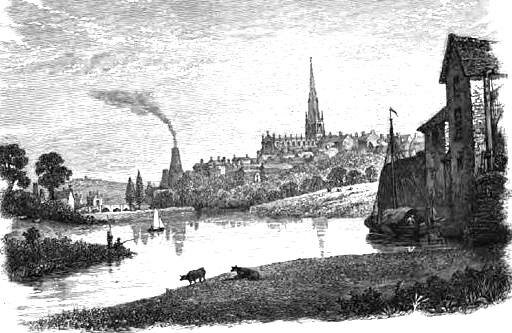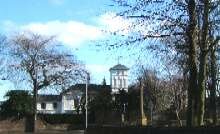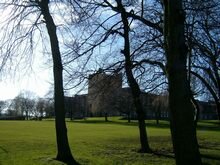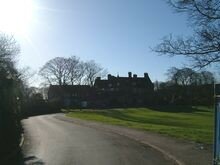Brief History of Rotherham

Extract from The Parliamentary Gazeteer of England and Wales, 1851:
The annual income of the grammar school, in 1830, was £23 15s. 4d; of the charity school, £77 10s; of Hollis's charity school £20.
The Rotherham Independent Academy or college was established here in 1795, and is fitted up for the accomodation of 23 students.
Almshouses for 4 unmarried women were founded in 1780 by Mrs. Bellamy; income, in 1830, 66pounds 3s.6d.
The Rotherham Poor Law Union comprehends 27 parishes, embracing an area of 79 sq. miles; with a population returned, in 1831, at 23,543.
The streets of Rotherham are narrow and irregular, and the houses, though built of stone, have a mean appearance, with the exception of a few modern structures. The vicinity is pleasantly adorned with villas, etc. and abounds in mineral wealth.
Masborough is a suburban village, separated from the town only by the river and connected by the bridge. It originated in the establishment of the great iron works for which Rotherham has been celebrated, and came ultimately to contain a population exceeding that of the remainder of the town, and chiefly employed at Messrs. Walker's iron works.
Rotherham has long been celebrated for its artificers in iron. "In Rotherham," says Leland, in the reign of Henry V111, " be very good smithies for all cutting tools." The "yerth cole" was also known, though it cannot be said to have been celebrated in those days. "Though betwixt Cawoode and Rotherham," says Leland, "be good plenti of wood, yet the people burne much yerth cole, bycawse hit is plentifully found ther, and sold good chepe. A mile from Rotherham be veri good pitties of cole."

The Gazetteer and General Directory of Sheffield 1852 describes Rotherham : Rotherham is a busy market town on the navigable part of the River Don and has long been celebrated for it's iron and steelworks; its noble gothic church; its extensive corn and cattle market; and for the glasshouses, potteries, and iron and coal works in its vicinity.
It is more ancient than its neighbour Sheffield. The houses are generally of stone and some of them are handsomely and substantially built, but owing to the low situation and the irregularity and narrowness of the streets, the town has rather a dull appearance.
Moorgate was the southerly approach to Rotherham, but until 1788, a toll was charged near the Red House Lodge, so a packhorse route turned northwards there and followed the valley to Hollowgate and Wellgate.
The Earls of Effingham held the manors of both Rotherham and Kimberworth. In 1775 the 3rd Earl built a small battlemented house as a vantage point overlooking the wide valley at the confluence of the Rivers Rother and Don, his Kimberworth Lands forming the far hillside. This was in fact Boston Castle, and was so named after political events in America. The Earl pronounced that no tea should ever be drunk there ! It was one hundred years later when Rotherham Corporation opened its first public park here - Boston Park.
Thundercliffe Grange, in Kimberworth, was a Grange of the Cistercian Abbey of Kirkstead, in Lincolnshire.The first traces of iron working go back to the 12th century, when the monks of Kirkstead Abbey had a smithy at Thundercliffe Grange. Previous to the erection of a Grange by the monks of Kirkstead, there appears to have been a small hermitage here, dedicated to St. John the Baptist. After the dissolution the Grange was bought by one of the family of Rokeby, and passing through the hands of several families, in quick succession, it became the property of The Right Hon. Thomas, the third Earl of Effingham, who took down the old Grange; and near its site, in about 1777, laid the foundation of the present site which was built by the Rotherham Architect John Platt. On his death, it passed to his brother Richard, the fourth Earl of Effingham, who made it for many years his summer residence. He died in 1816. It was the property of Kenneth Alexander Howard, Baron Howard, of Effingham, K.C.B until 1979 . I understand that it is now housing development consisting of flats.
 As industrial activity began to cloud the view from Boston Castle so those who had invested in the Don Valley were building homes along Moorgate.
As industrial activity began to cloud the view from Boston Castle so those who had invested in the Don Valley were building homes along Moorgate.
Moorgate and Whiston Groves were an early building association development which commenced in 1845. The secretary was John Guest, local historian, later the owner of Moorgate Grange and partner in Guest and Chrimes Ltd.
 By 1901 the Grange has passed to the Chrimes family and the residents of the Groves were a cross-section of the town's business and professional families. The Grammar School already 400 hundred years old had moved from town to the Independent College building in 1890.
By 1901 the Grange has passed to the Chrimes family and the residents of the Groves were a cross-section of the town's business and professional families. The Grammar School already 400 hundred years old had moved from town to the Independent College building in 1890.
Oakwood Hall was built for James Yates, of Yates Haywood, stovegrate manufacturers. He built Oakwood Grange for his daughter. Both Oakwood Grange and Moorgate House finished their days as Children's Homes and were eventually demolished. Oakwood Hall became a hospital in 1916 and survives as part of the Rotherham District General Hospital Site.
 Red House was for fifty years the home of the Micklethwaits. With nearby Sitwell House it passed to the United Steel Co.Ltd. The parkland area between was accomodated and came to be known as Swinden Labs.
Red House was for fifty years the home of the Micklethwaits. With nearby Sitwell House it passed to the United Steel Co.Ltd. The parkland area between was accomodated and came to be known as Swinden Labs.
Whiston Grange and Lane End House belonged to Frederick Parker Rhodes, local solicitor and his brother Charles a mining engineer. Whiston Grange made way for modern housing but Lane End House still exists.
Canklow Wood was destroyed by firewood collectors during the General Strike but remains an open space, the woodland gradually regenerated.
Rotherham borough and district,lies at the confluence of the Rivers Don and Rother. It expanded rapidly after the founding of ironworks in 1746, and in the 19th century it became part of a continuous industrial belt extending along the Don Valley from Sheffield to Mexborough. Historically a centre for coal, iron and steel, and glass industries, Major industries in the area now are: engineering, steel-making, automotive components, aerospace suppliers, food, call-centres, computers and IT, manufacturing. Transport»
